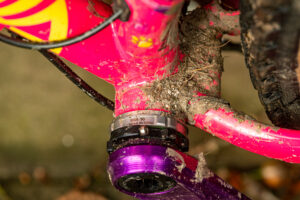Scuppered by chattery Suntour fork
Merida Big Trail 500 review
The Merida Big Trail 500 frame certainly looks modern, with its compact rear triangle, Boost 148mm dropouts, hourglass head tube and low-slung top tube.
In the past couple of years Merida has really upped its game. First came the test winning One-Sixty enduro bike then Merida went on to turbo charge the ebike category with its impressive range of EOne-Sixty suspension bikes.

Merida Big Trail 500 review
Merida hasn’t forgot about the humble hardtail though, where the Big Trail range is its take on the modern Plus-size hardtail. There are four models in the range, with prices starting at £1,350 for the entry-level Big Trail 500 tested here, topping out at £2,800 for the all-singing all-dancing Big Trail 800.
And while there’s a massive difference in price between the Big Trail 500 and 800, both bikes share the same frame and it’s only the build kit that changes.
The geometry and sizing are much more conservative than its styling however. Yes, it has the lowest BB height of the four bikes in test, and we’ll talk more about that later, but the head angle is almost three degrees steeper than the Sonder Transmitter, making it a much less aggressive bike.

Suntour Aion fork was marred by maddening knock
Suspension
Merida is the only brand in this test not to fit a RockShox fork. Instead, the Big Trail 500 gets a feature-packed Suntour Aion 130mm travel fork. It’s got a stout 35mm chassis and a murdered out finish, just like the new Revelation on the Sonder. It’s also air-sprung with external rebound and compression damping, and it sports a lock out.
One feature we really like is Suntour’s 15mm QLoc axle. It’s one of the quickest and easiest we’ve used. There are no threads in the fork lowers to damage and you can slot it in from either side of the Boost dropouts. It’s not immediately obvious how the neat QLoc mechanism works though, so you’ll probably need to read the instructions.

Single-ring set-ups now come as standard
Components
At mbr we’re big fans of 780mm handlebars, not least because you can chop them down to any width you like. So that’s a big thumbs up for Merida. We also like shorter stems, but the 35mm stem on the Merida is actually too short for the frame size. In fact, the Merida would feel much better with a 50mm stem, as it would open up the cockpit a touch and offset the relatively short 445mm reach measurement on the size L frame.
We’d also ditch the conical headset spacer from the off, as it makes it impossible to get the stem low enough. With the lowest BB height in test, the Merida also needs a correspondingly low handlebar height to make it feel balanced, and that’s just not possible with the conical headset spacer. Unless of course you flip the spacer and put it on top the stem to create a makeshift bird feeder.
We’ve got no complaints about the tyres on the Merida though. The 2.8in Maxxis Rekon’s are best in test by quite some margin, and combined with the 35mm rims, make a great Plus size package.

Inverted spacer is an ugly solution to lowering the stem
Performance
It’s always a bit of a gamble fitting a fork from one of the lesser known suspension manufacturers, and in the case of the Merida Big Trail 500 it didn’t pay off. On paper, the 130mm travel Suntour Aion ticks all the boxes. Out on the trail however, it feels like there’s a loose part inside the fork that knocks every time it compresses, even on the smallest bumps. It’s not like the fork isn’t working, it’s just the hydraulic knock is very annoying and distracting. So much so, it made it hard to access if the chattery ride of the Merida was due to the super stiff frame or the lacklustre performance of the fork.
The head angle on the Merida could also be slacker to give the bike more poise on steeper descents, so maybe a longer travel fork would be a good fit, as the BB height is certainly low enough to accommodate something with more firepower up front.

Verdict
We had high hopes for the Merida Big Trail 500. It had the best tyres in test; the 11-speed SRAM NX drivetrain never missed a beat and the sleek alloy frame looked badass. Looks can be deceiving however, and the sizing and geometry on the Merida aren’t as up-to-date as the Sonder. The real sticking point though is the Suntour Aion fork. It’s burly and brimming with features but its performance is undermined by an incessant knocking, making it the suspension equivalent of water torture. With a 150mm RockShox fork the Merida would be back in the mix, but it still wouldn’t have the measure of the Sonder.















